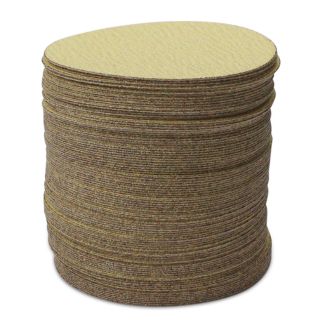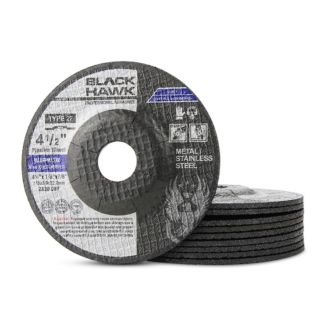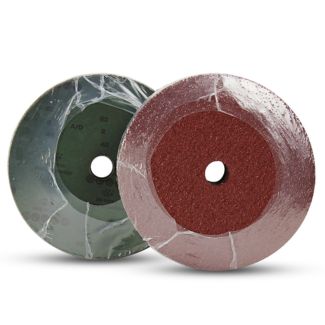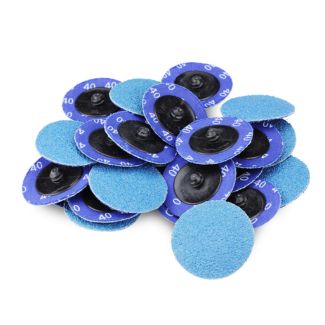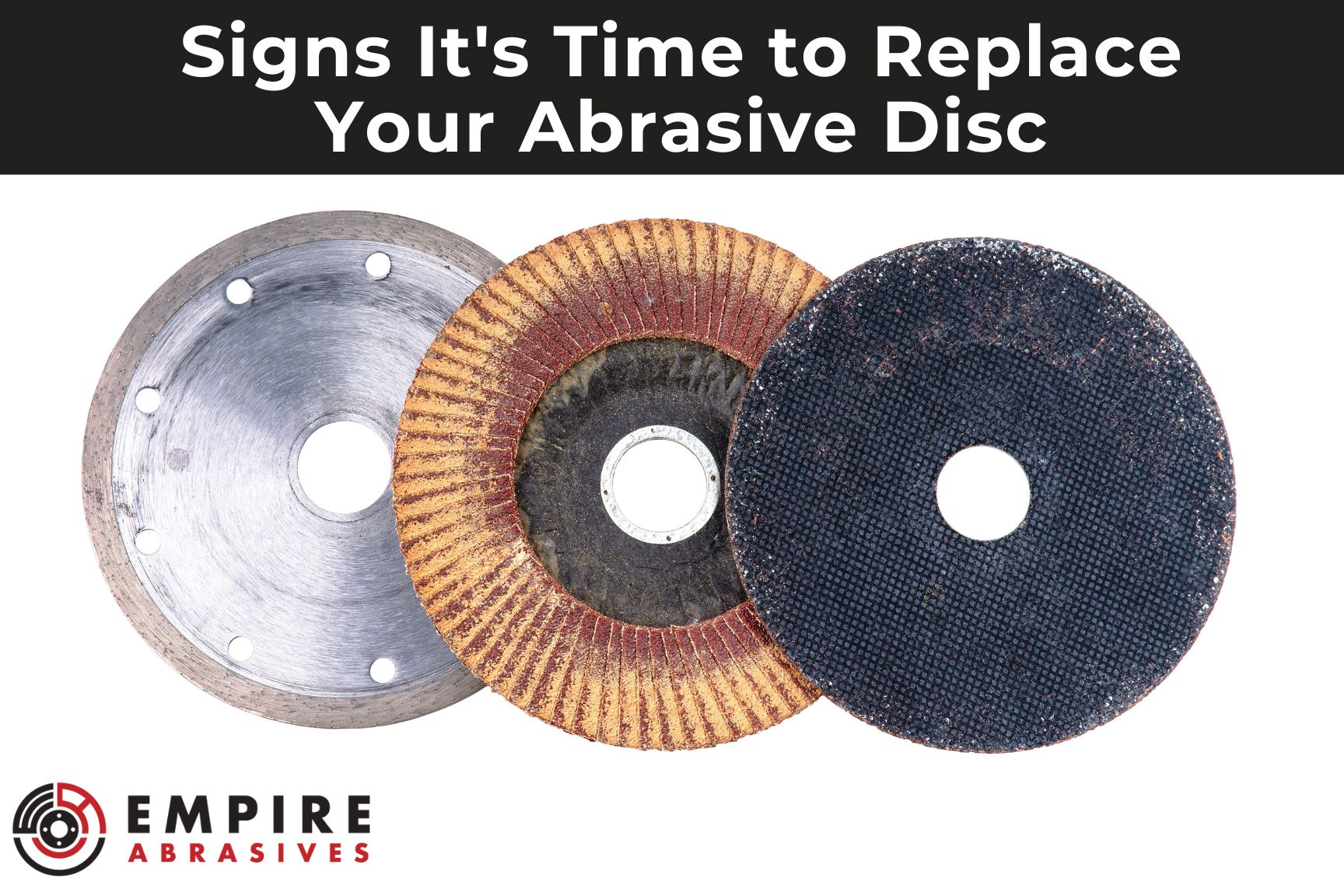
Abrasive discs come in all types and sizes to cut, grind, shape, and polish. From versatile flap discs to heavy-duty grinding wheels and precise sanding discs to specialized cut-off wheels, these tools are essential in metalworking, woodworking, automotive, and construction projects. However, abrasive discs are consumable products that have a limited lifespan, needing to be replaced often.
Using a worn-out or damaged disc isn't just inefficient; it can be dangerous, leading to poor finishes, damaged workpieces, and even potential injuries. In this guide, we'll walk you through the telltale signs that your abrasive disc is ready for retirement, ensuring you stay safe and get the best possible results in your projects.
Signs It is Time to Replace Your Abrasive Disc
1. Visual Inspection:
- Excessive Wear: Disc is noticeably thinner, uneven, or has significant material loss.
- Loading/Glazing: Abrasive grains are clogged with material, making the disc shiny and smooth.
- Burning/Discoloration: Disc surface shows signs of heat damage (blue/brown spots) or discoloration due to overheating or contamination.
- Chipping or Breaking: Disc develops chips, cracks, or breaks off in chunks.
- Fraying Edges, Cracks, Uneven Surfaces: (Additional visual cues for wear and tear.)
- Reduced Disc Diameter: Noticing a significant reduction in the disc's diameter due to prolonged use.
2. Decreased Cutting Performance:
- Slow Material Removal: It takes much longer for you to get your desired results.
- Increased Effort: You need to apply more pressure than usual.
- Poor Surface Finish: The resulting surface is rough or uneven.
- Loss of Cutting/Grinding Precision: Impacts work quality and may require rework.
3. Unusual Noises or Vibrations:
- Squealing/Grinding Sounds: Disc emits high-pitched or harsh noises during use.
- Excessive Vibration: Tool vibrates more than usual, causing discomfort or instability. Not only can this be uncomfortable, but it can damage your expensive power tools.
4. Change in Dust Pattern:
- Reduced Dust: Worn discs produce less dust as the abrasive grains wear down.
- Change in Dust Color: May indicate the abrasive is breaking down.
5. Uneven Wear Patterns:
- Uneven Material Removal: Some workpiece areas appear to get sanded more than others.
- Disc Shape Distortion: Disc becomes warped or misshapen.
6. Signs of Overheating:
- Smell of Burning: Indicates excessive friction and heat buildup. This can lead to a potential fire hazard if the disc is used in this condition.
- Sparks Flying: More sparks may be generated due to increased friction.
- Tool Overheating: The tool itself gets excessively hot to the touch.
- Burn Marks on the Workpiece: Caused by heat buildup from a worn disc.
7. Disc Slippage:
- Loose Attachment: Disc doesn't stay securely mounted, slips, or spins freely.
- Safety Concerns: Slippage can cause damage to the workpiece and pose a safety risk.
8. Age, Usage, and Storage:
- Frequent Use: Discs wear down faster with regular use.
- Storage Conditions: Improper storage can accelerate wear and degradation.
- Expired Shelf Life: Adhesive bond can deteriorate over time, especially with improper storage.
9. Project-Specific Requirements:
- Fine Finishing: Some projects demand fresh high grit sanding discs for optimal results.
- Matching Disc to Task: Importance of choosing the right disc for the material and application.
When NOT to Replace Your Discs
Even though we make our money selling abrasives, we don’t want you to think that you need to replace your discs any time they aren’t working 100%. Some problems can be taken care of so you can get more grinding out of your discs.
- Loading/Glazing: If your disc is simply clogged with material or has a shiny, glazed surface, you can often restore its cutting ability through cleaning or dressing. A disc cleaning stick or a dressing stone can remove buildup and expose fresh abrasive grains.
- Minor Surface Imperfections: Small nicks or scratches on the disc's surface don't always necessitate immediate replacement, especially if they don't affect performance or balance. Monitor them closely for further deterioration and replace them when necessary.
- Temporary Loss of Performance: If you notice a sudden drop in performance, try adjusting your technique or the speed of your tool. Sometimes, applying too much pressure or using the wrong speed can wear down the disc prematurely.
- Minor Edge Fraying: Small amounts of fraying at the edges don't always mean your disc is ready for the trash. If the fraying is minimal and the disc is otherwise in good condition, you can often trim the edges carefully with scissors or a utility knife.
Additional Tips
- Regular Inspection: Make it a habit to visually inspect your discs before each use.
- Trust Your Gut: If something feels "off" about your abrasive disc – whether it's cutting slower, sounding different, or just not performing as expected – trust your instincts and inspect it closely or replace the disc.
- Maintain Your Discs: Proper storage, cleaning, and dressing can significantly extend the lifespan of your abrasive discs. Store them in a cool, dry place, clean them regularly to remove debris, and use a dressing tool to remove loading and glazing.
- Rotation and Balance: Regularly check the balance of your disc and rotate it, if possible, to ensure even wear.
- Matching Disc to Material: Always use the right disc type, abrasive grain, and grit for the material you're working with.
- Proper Technique: Using the correct technique can significantly extend the life of your abrasive disc. Avoid excessive pressure, maintain proper angles, and let the tool do the work.
- Speed Settings: Use the recommended speed settings for your specific disc type and diameter.
- Tool Maintenance: Keep your power tools well-maintained to prevent unnecessary stress on the abrasive discs.
- Invest in Quality: High-quality abrasive discs from reputable brands like Empire Abrasives are designed for longevity and performance. Shop our premium abrasive products.
Conclusion
Recognizing when to replace your abrasive discs is crucial for maintaining safety, efficiency, and quality in your work. At Empire Abrasives, we're dedicated to empowering your projects with top-tier abrasives and unparalleled expertise.
Have questions about selecting the right disc? Need advice on maximizing the lifespan of your abrasives? Our team of experts is just a call or click away, ready to provide personalized recommendations tailored to your specific needs.
When it's time to restock, you can count on our extensive inventory of premium abrasives, all ready to ship within one business day. Don't let worn-out discs compromise your work or safety. Reach out to Empire Abrasives today and experience the perfect blend of quality products and expert service.
Related Posts:
Choosing and Using the Right Abrasive
- "Choosing the Right Sanding Disc" - Learn more about selecting the perfect disc for your project.
- "Flap Discs - A Great Multi-Tool" - Discover the versatility of flap discs.
- "Sandpaper Grit Explained" - Understand how grit affects your abrasive's performance.
- "Flap Discs vs Grinding Wheels: A Side-by-Side Comparison" - Help in choosing the right abrasive tool.
Abrasive Types and Materials
- "Ceramic vs. Zirconia Abrasives: Which is the best option?" - Explore the differences between ceramic and zirconia abrasives to determine which is best suited for your needs.
- “Are Ceramic Abrasives Better?” – Learn about the advantages and disadvantages of ceramic abrasives to see if they're the right choice for your projects.
- “Silicon Carbide vs Aluminum Oxide Abrasives” - Learn about the unique properties and applications of silicon carbide and aluminum oxide abrasives.
- “Aluminum Oxide vs Zirconia Abrasives” – Compare the performance and characteristics of aluminum oxide and zirconia abrasives to make an informed decision.
- “Aluminum Oxide 101 - Why is it Such a Common Abrasive?” – Discover the reasons behind the widespread use of aluminum oxide in various industries and applications.
- "Types of Abrasives: Bonded vs Coated vs Non-Woven Abrasives" - Understand the different types of abrasives and their specific uses in various applications.
- “Understanding Friability in Abrasives: What It Is and Why It Matters” – Learn about friability, the ability of abrasive grains to fracture, and how it impacts abrasive performance.
Maintenance and Troubleshooting Guides
- "Resin Fiber Discs: Storage and Handling" - Tips to extend the life of your abrasive discs.
- "How To Clean Sanding Belts and Tips to Extend Belt Life" - Maintenance tips applicable to various abrasives.
- "8 Most Common Mistakes Made When Using Abrasives" - Avoid common mistakes that can shorten the lifespan of your abrasives and compromise your results.
- "Coated Abrasives 101: How to Store and Maintain Them Properly" - Discover essential tips for storing and maintaining coated abrasives to ensure they remain in top condition.
- "Troubleshooting Common Abrasive Tool Issues - Flap Discs" - Get specific guidance on identifying and resolving common problems with flap discs.
- “Troubleshooting Common Abrasive Tool Issues - Cut-Off Wheels” – Learn how to troubleshoot issues with cut-off wheels to ensure safe and efficient cutting operations.
- “Troubleshooting Common Abrasive Tool Issues - Grinding Wheels for Angle Grinders” – Find solutions to common problems encountered when using grinding wheels on angle grinders.
- “Troubleshooting Common Abrasive Tool Issues - Surface Conditioning Discs” – Get expert advice on addressing issues with surface conditioning discs to achieve optimal surface preparation.

